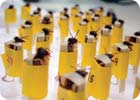Bees 'Smell' Danger; Teens Hate Mosquitoes

Honeybees as explosives detection system? Bees can detect explosives in the presence of potentially interfering agents, such as lotions, motor oil or insect repellant.
Had enough of the hype over emerging threats and unique solutions? Then read on. These threats and solutions are also attracting unique and effective alternatives, ranging from honeybees that sniff out explosives to mosquitoes that sting teens' ears.
Sting ‘Em
Initially, the concept seems too incredible to be possible -- train a common honeybee to physically respond to the distinctive smell of specific explosives, then develop a method for measuring or observing that response in order to use the bee’s reaction to the smell of explosives as a natural explosives detector. As incredible as it may seem, Los Alamos Laboratory scientists recently created such a detector under the Stealthy Insect Sensor Project.According to Tim Haarmann of Molecular Microbiology and Immunology, principal investigator for the project, the plan applies old knowledge to a pressing new problem. “Scientists have long marveled at the honeybee’s phenomenal sense of smell, which rivals that of dogs,” Haarmann told Security Magazine. “But previous attempts to harness and understand this ability were scientifically unproven. With more knowledge, our team thought we could make use of this ability.”
By studying and training bees, Haarmann and members harness the honeybee’s exceptional olfactory sense by using the bees’ natural reaction to nectar, a proboscis extension reflex (sticking out their tongue) to record an unmistakable response to a scent. Using Pavlovian techniques, researchers were able to train the bees to give a positive detection response when exposed to vapors from TNT, C4 and TATP explosives.
The Laboratory team began with research into why bees are such good detectors, going beyond merely demonstrating that bees can be used to identify the presence of explosives. By looking at such attributes as protein expression, the team sought to isolate genetic and morphological differences between those bees with good olfaction and those without. They also determined how well bees could detect explosives in the presence of potentially interfering agents, such as lotions, motor oil, or insect repellant. In addition, the team studied structural units in the honeybee’s antenna and looked for biochemical and molecular mechanisms that could advance their ability to be trained.

This device produces a signal that is audible only to teenagers so that businesses can make them unwelcome.
Teenage Problems
If your security challenge is more about teenagers than white powder, check out Kids Be Gone. From North American Video, Mosquito Ultrasonic Teenager Deterrent Device by UK manufacturer Compound Security Systems is a non-invasive ultrasonic device that has been specifically designed to disperse groups of teenagers who may be loitering in areas where they could prove to be a nuisance. The device produces a signal that is audible only to teenagers. Although the sound is not painful it does become highly irritating after five to ten minutes exposure, and teenagers tend to leave the immediate area. Because of natural hearing loss, those over 30 years of age will be unaware of the noise. The system, which has an effective range of about 50 feet, is totally safe even after prolonged exposure.Looking for a reprint of this article?
From high-res PDFs to custom plaques, order your copy today!




